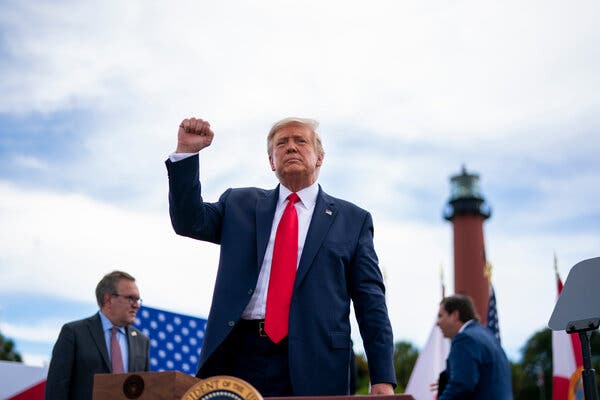
The flag of Greenland flies near the Eqip Sermia Glacier in Greenland on July 31. (Sean Gallup/Getty Images)
On Thursday, the Wall Street Journal reported that President Trump has expressed a repeated interest in purchasing Greenland, the autonomous Danish territory that lies between the north Atlantic and Arctic oceans.
While the president’s motives are uncertain, the administration probably sees strategic value in controlling more of the territory. Holding Greenland would provide added leverage in the Arctic, where the United States faces increased competition from Russia and China.
Many took the news as farce, but it’s not the first time a U.S. president has considered buying the ice-covered territory. Secretary of State William H. Seward considered buying both Greenland and Iceland, a project he abandoned after his Alaska purchase deal met with fierce criticism. More recently in 1946, President Harry S. Truman’s administration offered $100 million in gold for Greenland, to fortify it against Soviet expansion.
But buying Greenland is a nonstarter, and not simply because the economic costs are unfathomable. Rather, since the 19th century, norms of national identity have transformed territory from a tradable commodity to indivisible and nonnegotiable parts of sovereign nations.
[Trump wants to buy Greenland. He might want to know about the toxic nuclear waste buried in its ice.]
1. Nationalism means territories are not for sale.
Up until the mid-19th century, territorial purchases and exchanges were integral to international politics, allowing states to gain control over strategically and economically valuable territory without resorting to war. Before its brutal campaign against Native American tribes, U.S. westward expansion relied on territorial purchases — such as the 1803 Louisiana Purchase, the Transcontinental Treaty (ratified in 1821) and Seward’s 1867 Alaska Purchase. In Europe, the great powers managed their competition through the vigorous horse-trading of territory.
By the mid-19th century, the rise of nationalism rendered territory largely indivisible, unable to be exchanged, purchased or conquered. Nations began to identify their territories as “homelands.” Stories of nations conquering, cultivating and fighting over sacred ground made the idea that sovereign states could blithely trade or purchase territory unfathomable.
This norm of indivisible territory holds, even in places where the national attachment to territory seems weak. In 1946, William C. Trimble, assistant chief of the State Department’s Division of Northern European Affairs, wrote in a memo that the Danes wouldn’t mind relinquishing Greenland, as “there are few people in Denmark who have any real interest in Greenland, economic, political or financial.” But the Danish prime minister replied that “it would not be in accordance with our honor and conscience to sell Greenland. The Greenlanders are and feel they are our countrymen and we feel tightly bound to them.”
Viewing territorial purchases as illegitimate isn’t necessarily a bad thing. Nationalism has made fighting over territory more costly, and thus conquest less likely. But there are downsides: Leaders’ inability to trade or purchase territory makes negotiating conflict much more difficult — think Kashmir, Jerusalem or Taiwan. Whatever the consequence, outright territorial purchases are largely off the table as legitimate instruments of international politics.
[Why Kashmir may see increased violence after the revocation of Article 370]
2. Leasing is the route to influence in Greenland — and the United States already does this.
Despite strong norms, there are times when nations need to be able to control, purchase and exchange their territory. How do leaders accomplish this? Instead of outright purchases, which would violate a nation’s sovereignty, diplomats employ tools that recognize a nation-state’s inviolable sovereign control over its territory, yet allow another country to control the territory in practice.
This is why leasing is a popular instrument. As political scientist Alexander Cooley writes, “in a lease sovereignty is shared according to clear, prearranged guidelines. One side retains formal control, and the other gains use rights for a specified period of time.” Because the nation leasing the territory, in theory, retains control, its leaders can claim there is no infringement on national sovereignty.
Through leases, great powers can manage their control of foreign territory. Russia maintained strategic outposts in the former Soviet states via leasing agreements, without making claims that infringed on these new nations’ sovereignty. China has leased territory in Djibouti, Pakistan and Sri Lanka. And leases form the foundation of the U.S. global network of military bases.
[The U.S. and China are playing a dangerous game in the South China Sea]
Indeed, this is precisely how the United States maintains its strategic interests in Greenland. In 1941, the first U.S. lease “explicitly [recognized that] the Danish sovereignty over Greenland” granted “to the United States the right to locate and construct airplane landing fields and facilities for the defense of Greenland and for the defense of the American Continent.” After World War II ended, and the United States failed to purchase Greenland, the NATO treaty gave the United States rights to build bases at Thule and Sondrestrom.
So the United States already successfully secures its interests through leases and alliances — but it’s not a foolproof system. Local populations can still bristle against what they see as violations of national sovereignty. When the United States attempted to upgrade Thule’s missile defense system without Greenland’s approval, for example, Greenlanders pushed back, claiming the United States acted akin to “colonial times.”
3. Territorial politics isn’t a real estate deal.
Trump’s musings over Greenland are part of his larger tendency to see territory as a tradable commodity, particularly in dealing with the Middle East. During the 2016 Republican presidential primary debates, candidate Marco Rubio chastised candidate Trump for treating Palestinian aspirations for statehood as a “real estate deal.” Jared Kushner’s plan for Middle East peace relies on territorial exchanges between the Palestinians, Jordan and Egypt. Trump’s March tweet recognizing Israel’s control over the Golan paid little attention to the symbolic claims at stake.
This is a dangerous approach to territorial conflict. As recent events in Kashmir make clear, nations are still prepared to shed blood and treasure to secure national claims. Understanding the symbolic value of territory is key to managing this and any future territorial disputes.
In other words, Trump’s real estate approach to Greenland may be the tip of the melting iceberg.
Don’t miss anything! Sign up to get TMC’s smart analysis in your inbox, three days a week.
Stacie E. Goddard is a professor of political science and faculty director of the Madeleine K. Albright Institute of Global Affairs at Wellesley College. She is the author of “When Right Makes Might: Rising Powers and World Order.”


